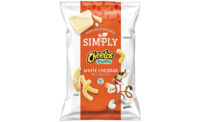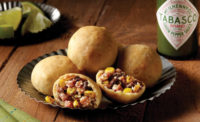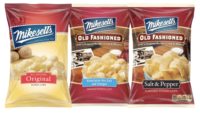Thanks to Americans’ increasingly hectic lifestyles, sales of grab-and-go items like salty snacks, including chips, popcorn and pretzels, are increasing, according to the June 2018 “Salty Snacks: U.S. Market Trends and Opportunities” report from Packaged Facts. Convenience is cited as a top purchase driver.
“The state of the snack food market is ever-evolving,” says Amber Glover, business development manager, Asenzya, Oak Creek, WI. “More and more often, the consumer isn’t eating three square meals a day. Instead, they rely on several snacks to help them get through their busy schedules.”
Contributing to growth is the fact that salty snacks are readily available in vending machines, gas stations, and convenience stores—which only increases their appeal among rushed shoppers. Though competition does exist from chocolate confections, cookies, and crackers, Packaged Facts estimates that sales of salty snacks will exceed $29 billion in 2022.
“Propelling the overall sales growth in the salty snacks category is that consumers, particularly millennials, are demanding a wider variety of options and flavors than ever before,” says Denis Neville, CEO, CoreFX Ingredients, Chicago. “As a result, the industry has experienced widespread product proliferation and a growing consumer interest in healthy snack options has further fueled product innovation.”
By the numbers
Data from IRI, Chicago, shows that sales of nearly every segment of salty snacks is on the rise, with the overall category up 4.68 percent to $23.7 billion for the 52 weeks ending April 22, 2018.
Sales of potato chips posted sales of $7.5 billion alone, growing 2.07 percent in dollar sales, mainly thanks to growth from Frito-Lay’s potato chip brands, which were up 2.24 percent to $4.5 billion. Ruffles had a particularly strong year, up 18.22 percent to $1.0 billion.
Frito-Lay’s better-for-you multigrain chip brand SunChips had a strong year, up 17.43 percent to $246.0 million. The line is part of the growing other salted snacks segment—featuring several types of extruded snacks that don’t fit into the cheese snacks or corn snacks segments—which was up 9.23 percent to $4.4 billion.
Pretzels likewise grew, up 1.61 percent to $1.2 billion. Segment leader Snyder’s-Lance (now part of Campbell Soup Co.) grew 2.02 percent to $462.4 million. Its Snyder’s of Hanover brand was responsible for the overwhelming bulk of that revenue, up 2.89 percent to $431.6 million.
Ready-to-eat popcorn and caramel corn grew 5.00 percent to $1.3 billion. Frito-Lay brand Smartfood leads the way and was up 13.89 percent to $389.1 million. The Angie’s Boomchickapop brand, purchased by Conagra Brands in 2017, grew a whopping 49.97 percent to $107.7 million.
Sales of tortilla and tostada chips grew 4.18 percent, reaching $5.3 billion in sales. Frito-Lay’s Doritos brand dominates and grew 6.07 percent to $2.2 billion. Organic also showed strength, with Late July growing 19.69 percent to $43.2 million.
Snack crackers—part of the all other crackers segment of the overall crackers category—also had a good year. Segment leader Cheez-It brand from Kellogg Co. grew 3.35 percent to $790.2 million, while Pepperidge Farm’s Goldfish crackers grew 3.58 percent to $572.8 million.
Leading trends
Packaged Facts says that future growth in salty snacks will come from products that carry the most flavor while also being healthy and nutritious.
Flavor trends on the radar at CoreFX Ingredients include spicy Asian, Mexican, vinegar and sweet flavors. Salt (including sea salt), cheese and roasted flavors are also among mainstream flavors that continue to resonate with shoppers, says Neville. At the root of these trends? Foodie culture, he says. “Demand for more exotic flavors has increased, including exotic blends with coconut and spices, or sweet and savory hybrids with honey.”
According to Glover, ever-changing flavor trends are translating to a shift away from permanent flavor extensions. Instead, she says, companies are focusing on limited-time offers (LTOs). “A big example is every fall, pumpkin spice comes out of the woodwork to sell hundreds of different products. Consumers are looking for truly authentic flavors—American regional, ethnic, fusion. However, all of these flavors are typically shown on an LTO.”
Causing this drive toward natural and authentic flavors, says Neville, is actually another main trend impacting salty snacks: the shift to clean label. “Consumers today are on a quest for transparency, opting for products made with ingredients that are simple and free from trans fats, gluten, preservatives, GMOs, and artificial flavors and colors.”
CoreFX offers authentic, dry, grass-fed butter and cheese ingredients that are clean label, fully traceable and full of protein, micronutrients, flavor and functionality appropriate for a wide range of salty snack applications. “For example, our dry grass-fed butter works very well as a topical slurry coating for popcorn,” says Neville, “which is a rapidly growing salty snack option due to its convenience, healthy halo and overall category innovation.” Additionally, the company’s dry cultured dairy ingredients, like sour cream, carry intense flavor concentrations that allow formulators to use less of the ingredient. The result is shorter labels and lower cost in use.
Clean-label trends are also spurring increased interest in better-for-you ingredients like whole grains, ancient grains and vegetable-based pulses, as well as anything gluten-free, organic and non-GMO. Sylvie Brunel, product and process development manager, notes that Clextral, Tampa, FL, has worked with processors over the course of the past year to develop new snacks based on pulses like quinoa, cassava and tapioca.
“As general consumer demand for healthier snacks grows, more and more food manufacturers are reducing sodium in products,” says Yusuke Hiraiwa, senior manager of national industrial sales and research and development, Kikkoman Sales USA, Inc., San Francisco, CA. “Substitutions, such as lower-sodium soy sauce used in place of salt, will help deliver savory flavor and umami benefits in salty snack products. Umami in soy sauce gives body and richness to the flavor, which supports the sodium reduction.
Kikkoman Granulated Soy Sauce and Granulated Gluten-Free Tamari Soy Sauce are instantly dispersible and soluble in water, eliminate dusting during production, and are less susceptible to caking. These ingredients blend well in topical seasoning mixes and work well in snack seasonings.
Food oxidation and overall safety are other clean-label issues that impact the salty snacks market. A significant part of the portfolio at Frutarom, North Bergen, NJ, includes solutions that reduce the oxidation of fats and oils, and target acrylamide reduction in baked and fried goods. “Acrylamide reduction is the biggest issue at the moment, from both the customer preference and legislation aspects,” says Dushka Dimitrijevic, director of technical sales and applications, food protection division. “There are a few solutions for that issue, targeting different mechanisms of acrylamide formation.”
Two of Frutrarom’s formulations, INOLENS 4 and SyneROX HT, were challenged in trials and showed good results. In trials with snacks, notes Dimitrijevic, the level of acrylamide was reduced by 60 percent.
Going forward, the salty snack market is expected to continue to grow, thanks to America’s obsession with snacking. “Snackification is possibly the most-powerful, consistent and long-term trend,” says Neville, “presenting companies with a wealth of opportunities for creative new product development, growth and better margins.”






